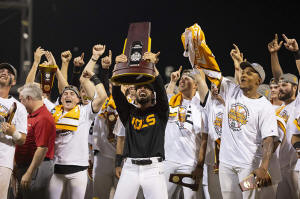College baseball future may see
greater imbalance in competition, high school prospects squeezed out
 Send a link to a friend
Send a link to a friend
 [February 20, 2025]
By ERIC OLSON [February 20, 2025]
By ERIC OLSON
The Division I baseball season is less than a week old, and coaches
already are planning for 2026 when it's all but certain scholarship
limits will be removed, rosters downsized and players will have
opportunities to make more money.
They expect the fallout to be fewer opportunities for high school
recruits at the top level of the sport, especially if the NCAA
adopts a proposal that would extend eligibility from four to five
years. They also predict a greater imbalance in competition.
All is contingent on a federal judge approving the settlement of
antitrust allegations against the NCAA and the nation’s biggest
conferences. A hearing is set for April 7 and changes would go into
effect July 1, a few days after the baseball season.
The framework for baseball would cap rosters at 34 with no
scholarship limit for schools that opt in to the revenue-sharing
model tied to the so-called House settlement. Currently there’s a
40-man limit during the season and a maximum of 11.7 scholarships
that can be spread among up to 32 players.
“I still think the majority of teams are going to be giving partial
scholarships to at least part of their roster,” Nebraska coach Will
Bolt said. “Reading the tea leaves, it doesn’t look like anyone is
going to come up with 34 fulls.”

No change in power structure
Auburn athletic director John Cohen, previously head coach at
Mississippi State and Kentucky, doubted the new rules would shake up
college baseball's power structure. Only about half of the more than
300 Division I programs currently award 11.7 scholarships, and many
of the ones that do could at least double that number next year.
Programs that don't award 11.7 now still might struggle to offer
that many going forward.
With just a handful of programs generating a profit, financial
constraints preclude big scholarship increases at most schools
without additional fundraising. Even for schools where increasing
scholarships is feasible, Title IX guidelines requiring proportional
opportunities for men and women would have to be considered.
The House settlement also would allow athletic departments to share
up to $20.5 million in revenue among athletes across all sports
starting next school year. Football and men's basketball players
would be expected to receive the lion's share. How much is available
to baseball players likely would be a fraction of what athletes in
revenue-producing sports get and could amount to little or nothing
for programs outside the Power Four.
Modest NIL earnings for most
Most players now receive partial scholarships and try to capitalize
on opportunities allowing them to make money on their name, image
and likeness. According to Opendorse's 2024 annual report, the top
25-earning baseball players could expect to make just under $48,000
per year, based on deals tracked by the NIL platform from 2021-24.
Cohen said that figure seemed low.
“What I know about NIL currently is there is no accurate way to
illustrate who’s doing what,” he said, “so it’s hard to speak
intelligently about NIL because what you’re relying on is
third-party information. You hear things and you just aren’t sure
what to believe.”
[to top of second column] |

Tennessee coach Tony Vitello, center, hoists the championship trophy
following his team's 6-5 victory against Texas A&M in Game 3 of the
NCAA College World Series baseball finals in Omaha, Neb., June 24,
2024. (AP Photo/Rebecca S. Gratz, File)

Clemson coach Erik Bakich said he thought the
$48,000 figure seemed high. Either way, he said, NIL money is not
lucrative for the vast majority of baseball players.
“The majority of NIL in college baseball has been about paying your
bills, not play for pay,” Bakich said. “College baseball players are
using NIL dollars to pay for cost of attendance. I’m for anything
that reduces out-of-pocket cost for parents and anything that
eliminates the need for any college kid to take out any type of loan
debt.”
Coaches said an often-overlooked consequence of roster reductions
would be the squeeze it puts on high school prospects, especially at
the top end of Division I.
Bolt, the Nebraska coach, said he had honest and difficult
conversations with some of his players last fall about where they
fit in and whether they should consider transferring, perhaps to a
lower division. Bolt typically has carried 45 or 50 players in the
fall. The NCAA fall roster limit remains fluid but coaches have
recommended it be 38 with the cutdown to 34 on Dec. 1.
Bolt said it takes the typical freshman about three semesters to
show whether he can be successful in Division I. The window of
opportunity probably will shrink after this year.
“Unless you’re a top-100 (high school) prospect or unless you’re
turning down significant money in the draft to go to college and
it’s a no-brainer you can play at the Division I level as a
freshman, the junior college route does become a very desirable
option," Bolt said.
Older players stick around
The shortening of the Major League Baseball amateur draft from 40
rounds to 20 beginning in 2021 has kept more players in college
longer. The transfer portal has allowed teams to fill immediate
needs rather than roll the dice with young players. And teams would
get older yet if there's passage of a proposal now under
consideration to extend athlete eligibility from four to five
competitive seasons.
There also is some question about how junior college years will be
counted against NCAA eligibility following the federal court
injunction that gave Vanderbilt football player Diego Pavia an extra
season after he argued his junior college years limited his ability
to capitalize on NIL.

Oregon State coach Mitch Canham said all those factors mean
promising high school players who don't project to be an immediate
starting position player or key member of the pitching staff will be
passed over in coming years.
“With a roster of 34, you don’t have room to keep a whole bunch of
guys around to develop, which is tough because that’s something
we’ve done a lot of,” Canham said. “It's almost as if, am I going to
trust an 18-year-old who has never played Division I baseball to
come in and do this? You better make sure. Or are you going to get a
21-year-old (transfer) who has hundreds of at-bats and experience
against older competition?”
All contents © copyright 2025 Associated Press. All rights reserved |